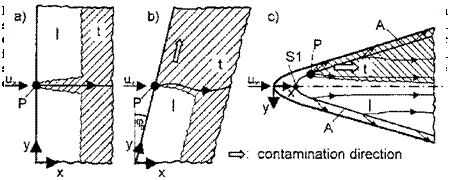Attachment-Line Contamination
Consider transition in the boundary layer on a flat plate or on a wing of finite span. Instability will set in at a certain distance from the leading edge and downstream of it the flow will become fully turbulent by regular transition. If locally at the leading edge a disturbance is present,[137] the boundary layer can become turbulent just behind this disturbance. In that case a “turbulent wedge” appears in the otherwise laminar flow regime, with the typical half angle of approximately 7°, which downstream merges with the turbulent flow, Fig. 8.9 a). Only a small part of the laminar flow regime is affected.[138]
At the leading edge of a swept wing the situation can be very different, Fig. 8.9 b). A turbulent wedge can spread out in span-wise direction, “contaminating” the originally laminar flow regime between the disturbance location and the wing tip. On a real aircraft with swept wings it is the turbulent boundary layer of the fuselage which contaminates the otherwise laminar flow at the leading edge [28].
The low-speed flow criterion [50]
![]()

0.4sin
y/v{due/dx*)Le.
illustrates well the physical background. Here sin ^u^ is the component of the external inviscid flow along the leading edge in the span-wise (wing-tip) direction, due/dx*)le. the gradient of the external inviscid flow in direction normal to the leading edge at the leading edge, and v the kinematic viscosity. Experimental data show that Ree ^ 100 ± 20 is the critical value, and that for Ree ^ 240 “leading-edge contamination”, as it was termed originally, fully happens. (For a more detailed discussion see [28].)
We see from that criterion the following: the larger the external inviscid flow component in the span-wise (wing-tip) direction, and the smaller the acceleration of the flow normal to the leading edge, the larger the tendency of leading – edge, or more in general, attachment-line contamination. Otherwise only a turbulent wedge would show up from the location of the disturbance in the chord – wise direction, similar to that shown in Fig. 8.9 a), however skewed.
“Contamination” can happen on general attachment lines, for instance, on those at the lower side of a flat blunt-nosed delta wing or fuselage configuration, Fig. 8.9 c). If, for instance, the TPS of a RV has a misaligned tile lying on the attachment line, turbulence can be spread prematurely over a large portion of the lower side of the flight vehicle. This argument was brought forward by D. I.A. Poll [51] in order to explain transition phenomena observed on the Space Shuttle Orbiter during re-entry, see also the discussion in [14].
The effect of attachment-line contamination in this case would be— temporally, until further down on the trajectory the ordinary transition
occurs—large and asymmetric thermal loads, a drag increase (which is not a principle problem for a RV), but also a yaw moment, whose magnitude depends on size and location of the contaminated surface part.
Attachment-line contamination in high-speed flows was studied since the 1960s, see the overviews in [14] and [11]. Poll made an extensive study of attachment-line contamination at swept leading edges for both incompressible and compressible flows in the 1970s [52]. Today, still all prediction capabilities concerning attachment-line contamination rely on empirical data. See in this regard also [53].











